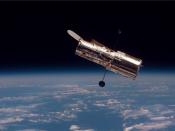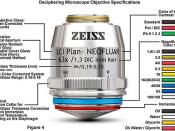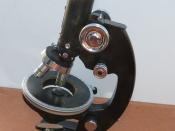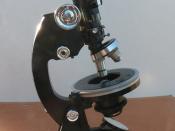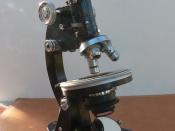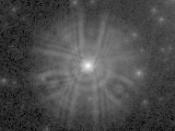Eyes:ÃÂLight tends to travel in straight lines.
ÃÂLens and cornea of our eyes bend light into a focused beam.
ÃÂCornea: outer most part of the eyes collects all the light that bounces off an object and focuses through a small hole (pupil).
ÃÂPupil: center of the eye, opens up wide more when itÃÂs dark to let in as much light as possible.
ÃÂIris: opens and closes around the pupil, depending on the amount of light there is.
ÃÂLens: right behind the pupil, focuses the light onto the back of the eyeball. Clear, curved, changed shape depends on what kind of things you want to focus on, acts like the lens of the camera.
ÃÂRetina: the back of the eye is coated with this special tissue, acts like the film of the camera, covered with photoreceptive cells (light sensitive cells)ÃÂThere are two kinds of photoreceptors on the retina: cones (6 or 7 million cones, can detect colors) and rods (more than 120 million rods, very light sensitive, can be even sensitive to a photon).
ÃÂLens projects image onto the retina, where the cones and rods transform the light and color into electrical impulses, and these impulses are transmitted up the optical nerve and into the brain, where the brain decodes the images.
ÃÂWhen lens of the eye focus an image on the retina, itÃÂs up-side down, but when the brain processes the images, it turns it back.
ÃÂRaptors have eyesight 10 times better than ours. Eagles also do.
Vision problems:ÃÂWhen light hits an object, it bounces off and is reflected into the eyes. Cornea and lens are light bending parts of the eyes; they focus the light onto the retina, a light sensitive tissue at the back of the eye.
ÃÂImages are mostly focus onto the retina perfectly. But some peopleÃÂs cornea is not shaped right, so they focus the image in front of the retina. Then the person is called myopic (nearsighted). Concave lenses refocus the light so it converges onto the retina.
ÃÂSome people have cornea that focus light behind the retina. They are hyperopic (farsighted). This can be corrected by the convex lenses.
ÃÂLaser surgery is another way to correct vision problems. A doctor uses the laser to reshape the cornea, so the cornea can focus the light perfectly onto the retina.
ÃÂAs the body ages, the eyes age too. The lens of the eyes become less flexible, so makes it harder to focus.
ÃÂMacular degeneration: an area of the retina, macula, gets worn down through wear and tear. People can experience empty or blurry spaces right in the center of their vision.
ÃÂGlaucoma: damage to the optic nerveÃÂCataracts: lens of the eyes get cloudy.
ÃÂAn eye doctor can be called an optometrist or ophthalmologist.
Telescopes:ÃÂTelescope capture and magnify light.
ÃÂRefractor telescope: The large lens in the opening collects the light bouncing off the distant object and focuses it at a point inside the body of the telescope. Then a smaller lens in the telescopeÃÂs eyepiece magnifies that focused light and projects it into the eyes. Since the light is magnified, the image takes up more space on the retina, so you see more details. Refractor telescopes use glass lenses to gather light.
ÃÂReflector telescope: uses a series of mirrors to gather and focus light. Light comes through the opening, reflected by a curved mirror onto a second mirror, which reflects the light into the eyes.
ÃÂAperture: the diameter of the lens or the mirror that gathers light. The larger the aperture, the more light the telescope can focus, and the brighter the image become.
ÃÂMagnification: the ability of the telescope to enlarge an image. ItÃÂs handled by the eyepiece and is depended on the combination of lenses that are being used.
ÃÂOptical telescopes: pirates use, they magnify visible light.
ÃÂBinoculars: two telescopes stuck together.
ÃÂThe Hubble telescope orbits in space.
ÃÂRadio telescopes: to study stars, collect data from satellite and space probes, collect radio waves.
Cameras:ÃÂCameras focus light onto film through a lens, so it can be made into images. Digital cameras donÃÂt use film.
ÃÂAll cameras have lens, a lens is made of pieces of glass, that work together to focus light. (like the lens in your eyes)ÃÂWhen you push the button on your camera, it opens up the shutter behind the lens. A shutter is a small sliding door that opens and closes really quickly. In film cameras, open shutters expose film to light coming through the lens.
ÃÂFilm: a thin plastic coated with emulsion, a special gelatin made of crystallized silver halides and other light sensitive materials. When light hits the emulsion, it causes a chemical change in the silver halide crystal; it breaks down into dark silver. The more light that let in, the darker the emulsion gets.
ÃÂThe particles on film cluster around the brightest areas of the image.
ÃÂAn object needs to reflect light in order to show up on film.
ÃÂNegative image: a picture where everything is reversed, the dark parks are light and the light parts are dark. In order to make a picture from the film, you shine light through the negative image to photographic paper that is coated with the same type of emulsion of the film. The negative piece of film produces a positive image on the paper.
ÃÂColor film uses three kinds of emulsions, one for red, one for blue and one for green. Those are the three primary colors of light.
ÃÂDigital cameras capture and store pictures in the form of digital data. Instead of hitting film, light coming through a digital cameraÃÂs lens is captured by an image sensor, called the charged-coupled device (CCD).
ÃÂCCD converts light into an electrical signal. They are made up of millions of light receptors called pixels.
ÃÂEach pixel records the brightness of light hitting it as a number. Some CCD can even tell what color of light is hitting it.
ÃÂBut most digital cameras detect colors using red, green and blue filters, which are basically just colored pieces of plastic or glass. Each filter only allows light of its own color through the image sensor. Software in the digital camera converts all the information about light intensity and color into a full colored image.
Microscope:ÃÂLight (optical) microscope: It uses light and more than one lenses to magnify small objects.
ÃÂLens: a piece of glass or other transparent materials that bend light. It can make objects smaller or bigger.
ÃÂLight microscopes magnify objects using a combination of convex lenses and concave lenses.
ÃÂLight is projected directly through the lens or bounces from a mirror mounted underneath the stage( a platform with a small hole in it, light comes through the hole and passes through a thin specimen you want to magnify)ÃÂSpecimen: mounted on a slide, a rectangular piece of glass or plastic.
ÃÂAfter passing through the specimen, light hits a series of objective lenses, which form an enlarged image of the specimen. Light from the objective lens set then moves through the tube to the eyepiece. There, the image is further enlarged by ocular lenses.
ÃÂKnobs that move the objective lens set closer to and father away from the specimen focus the image. The coarse focus knob makes big adjustments to put the specimen into general focus, and the fine focus knobs make finer adjustments.
ÃÂThe optical microscopes today follow the basic designs of the first compound microscope made around 1600 in Netherlands. The inventor is called Anton can Leeuwenhoek.
ÃÂElectron microscope uses a beam of electrons to produce really high resolution images. They can magnify much smaller images because the electron wavelengths are much smaller than those of visible light.
ÃÂScanning probe microscopes use an extremely fine point to see individual atoms or molecules on a materialÃÂs surface.
ÃÂUses of microscopes: looking at grains, checking out the atomic structures of a material.
